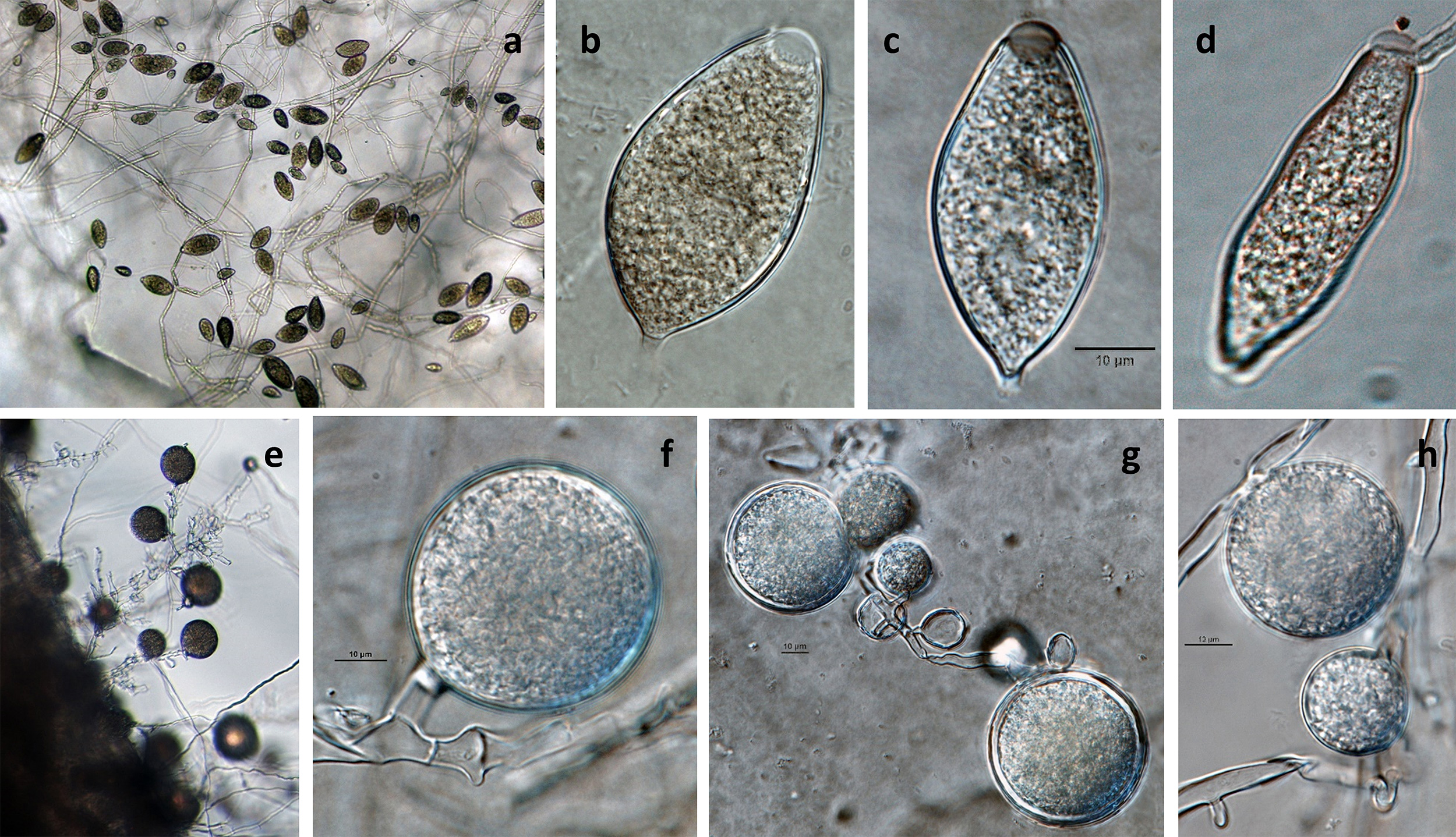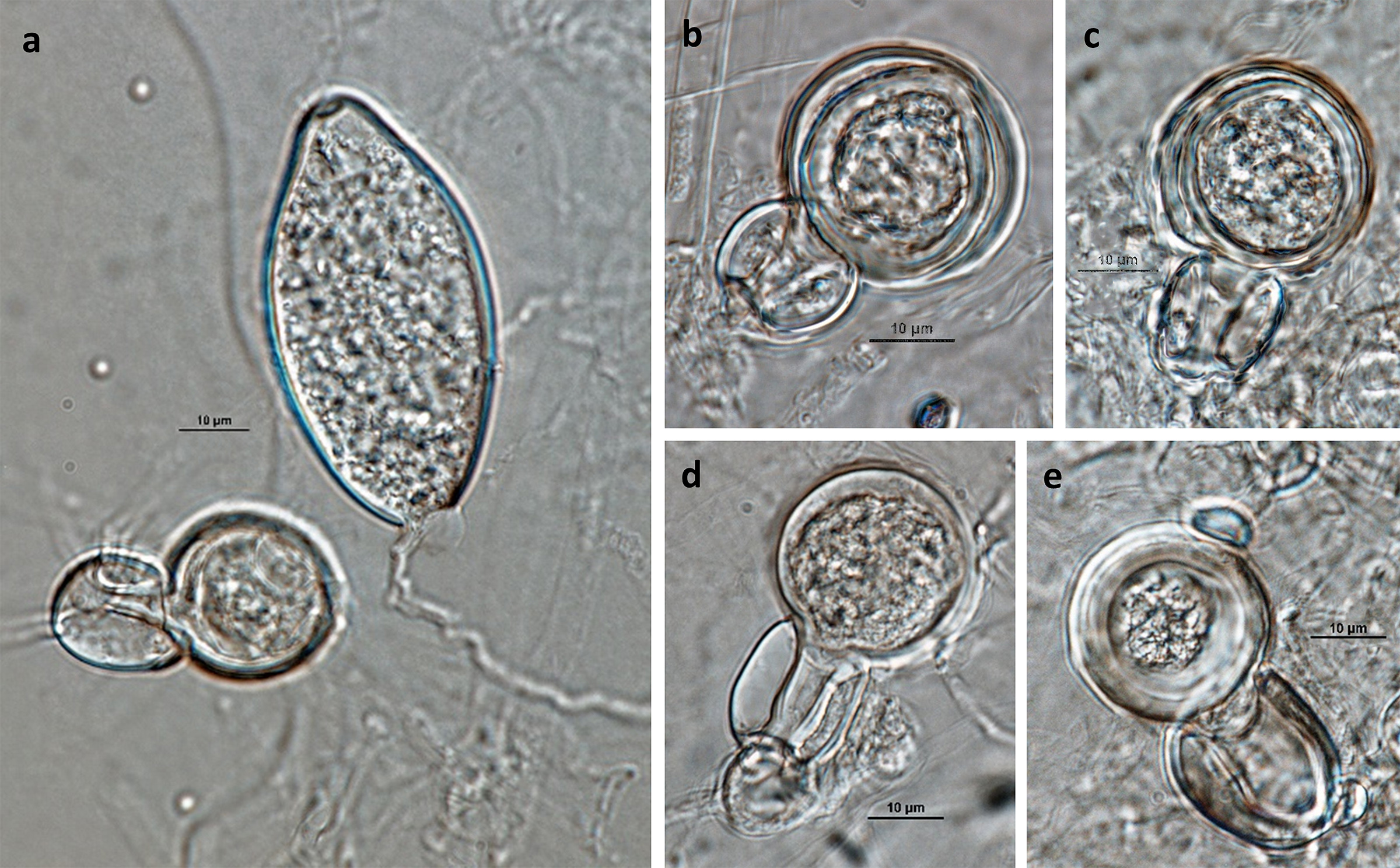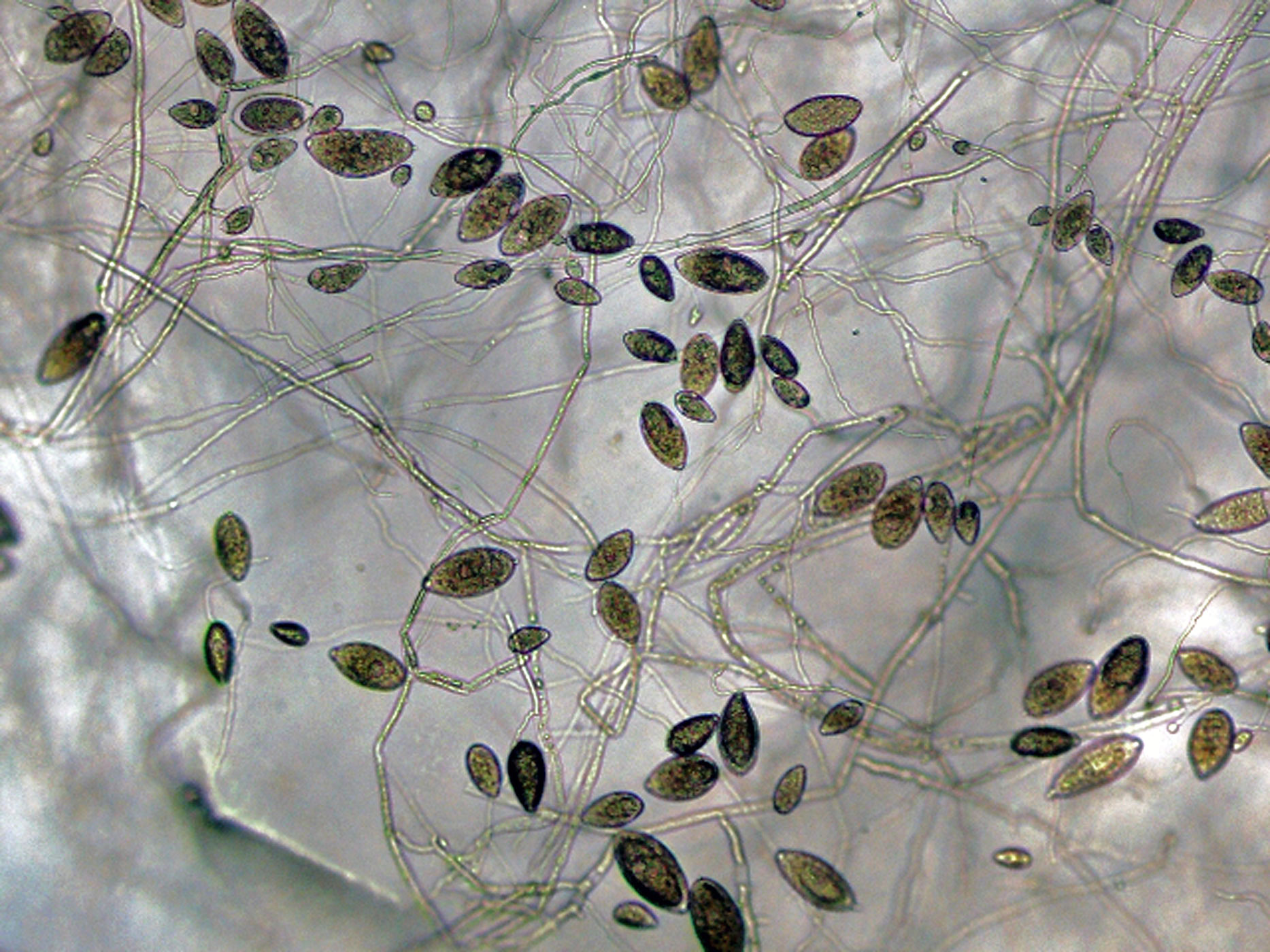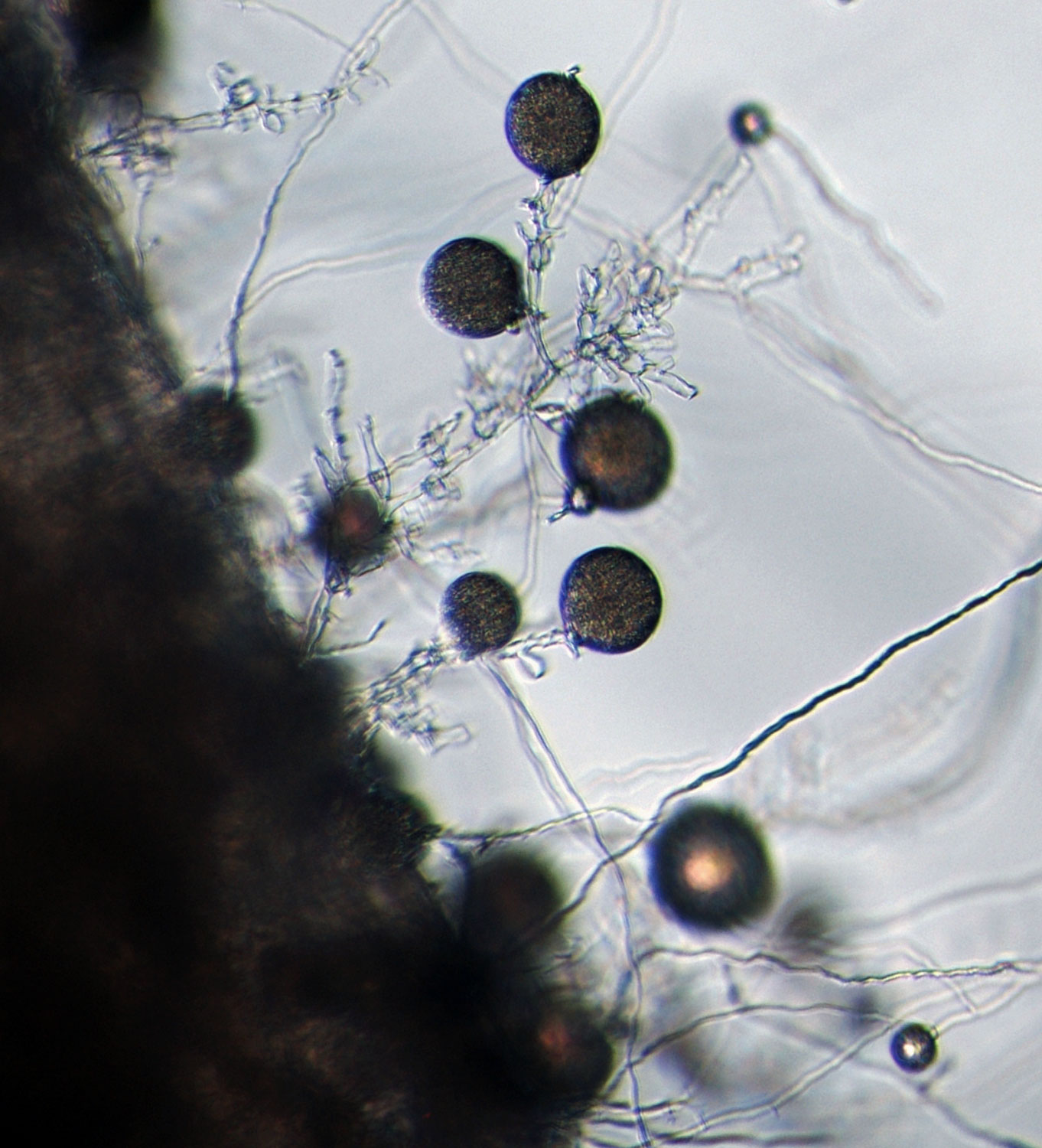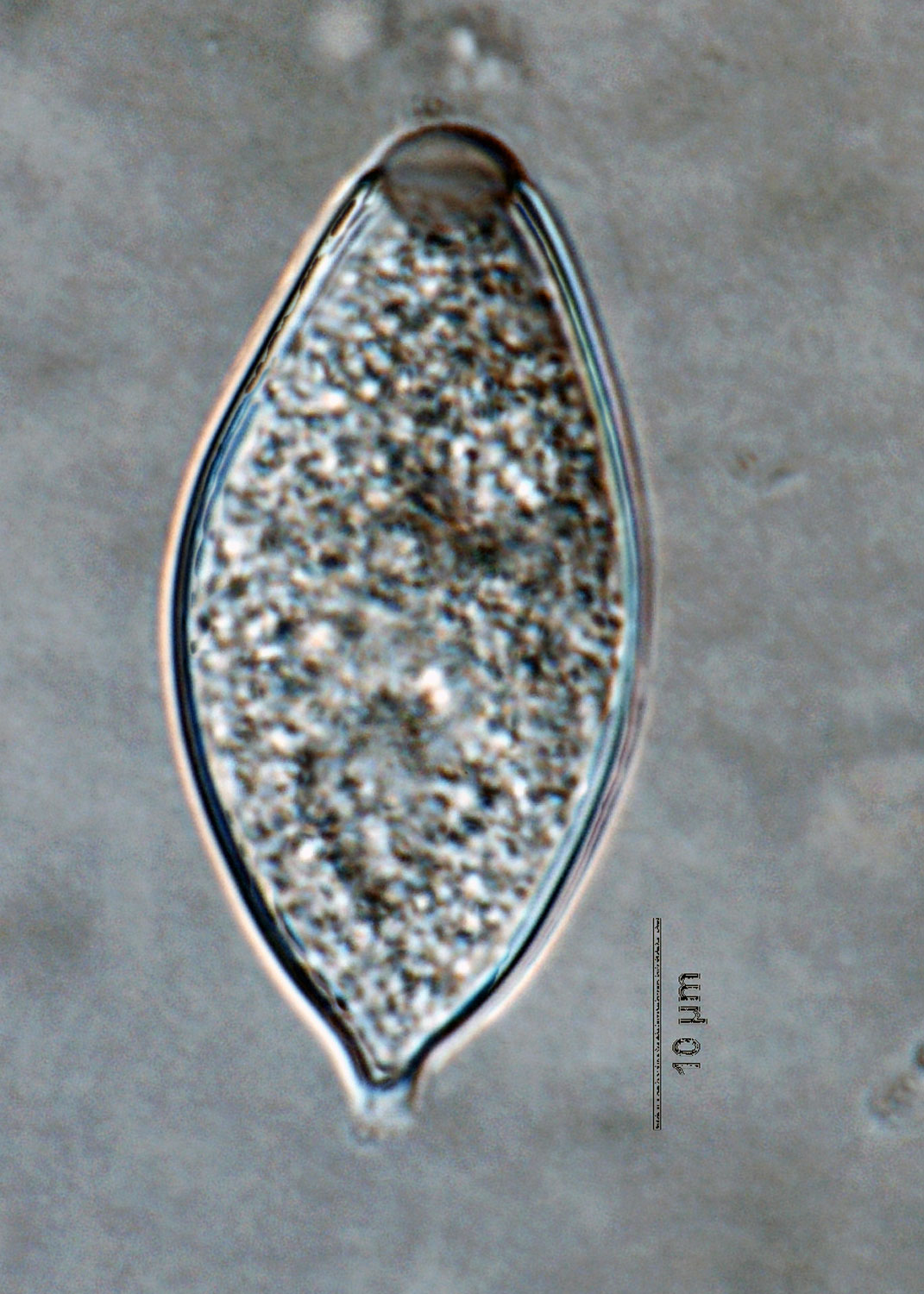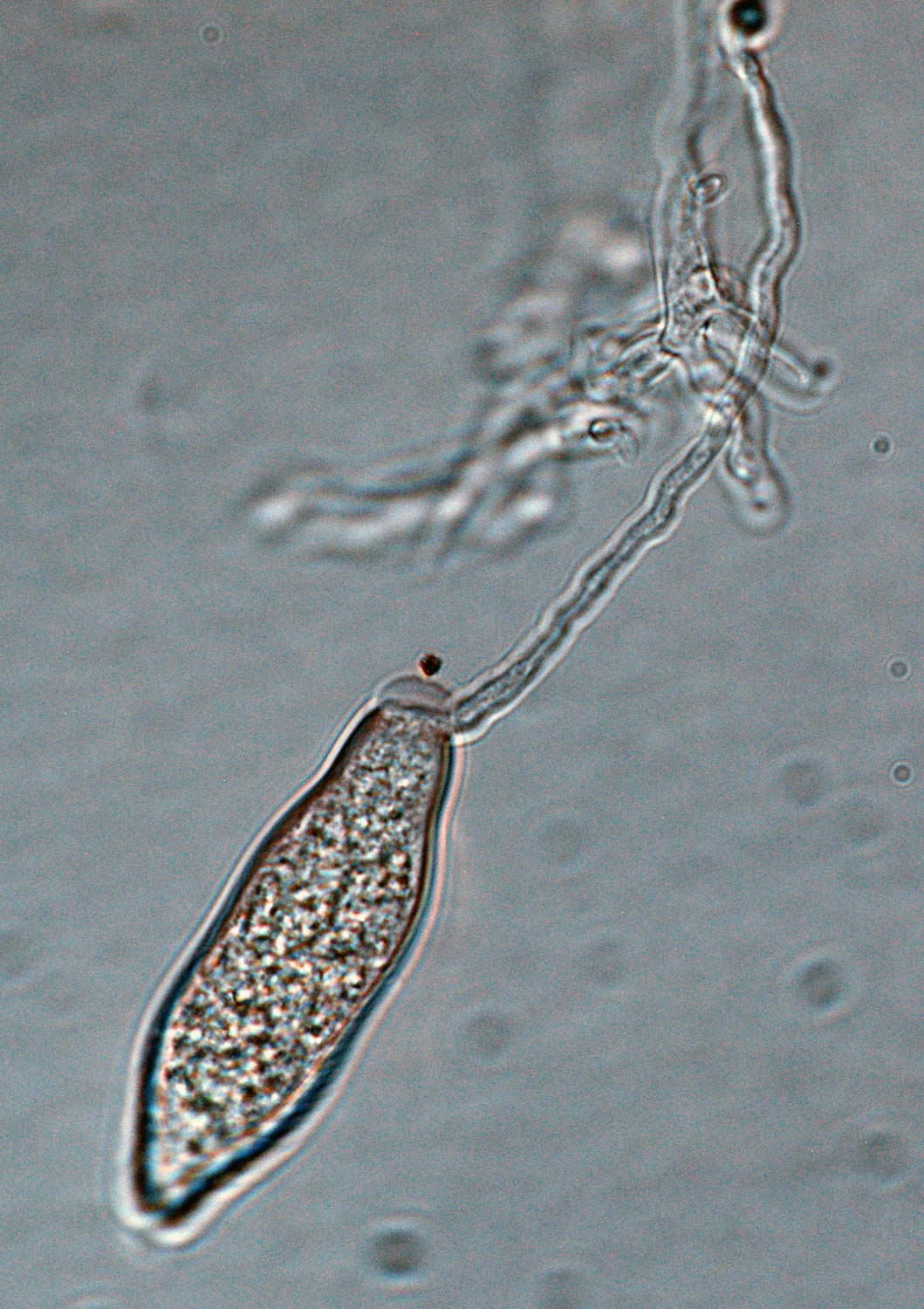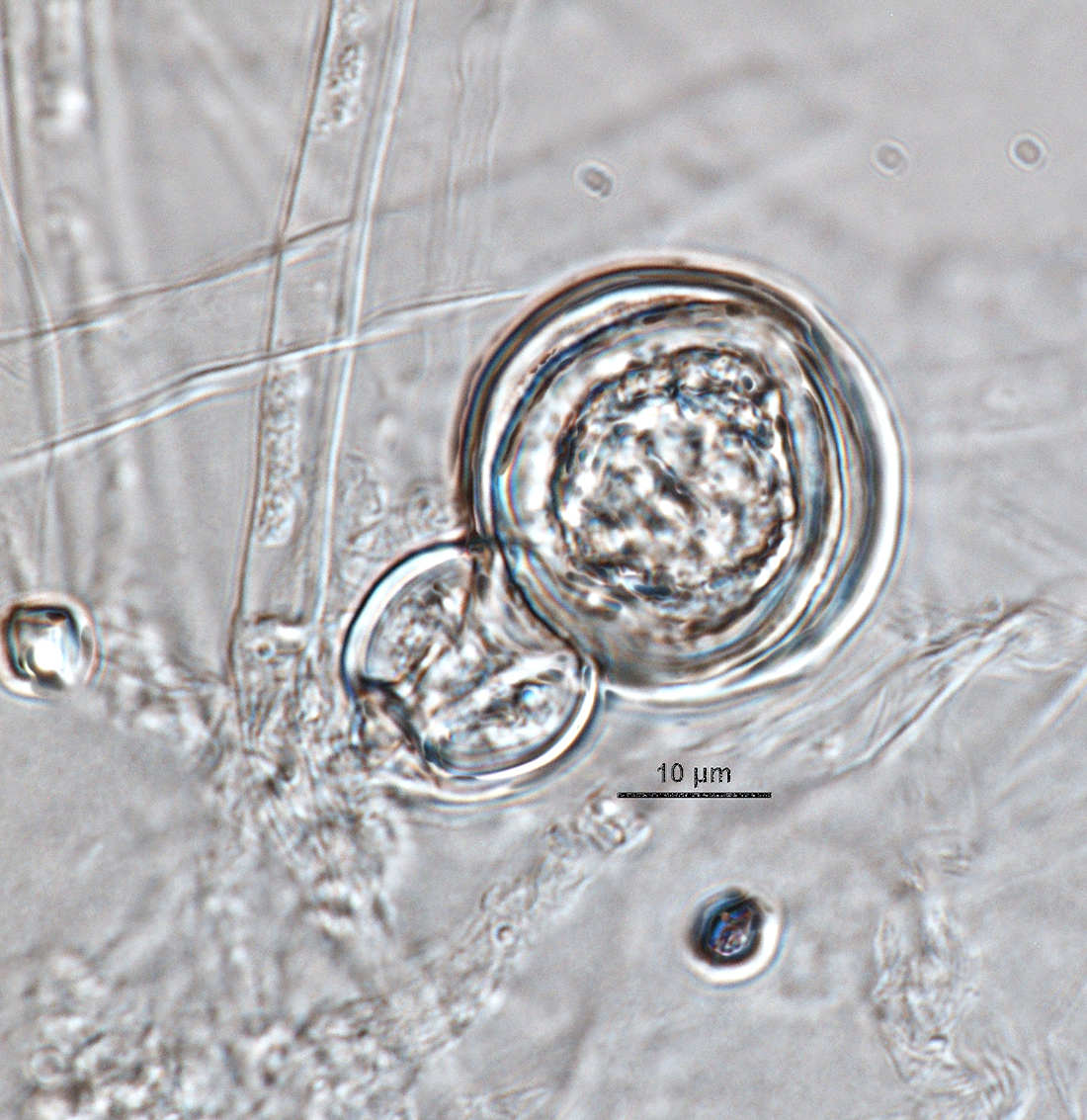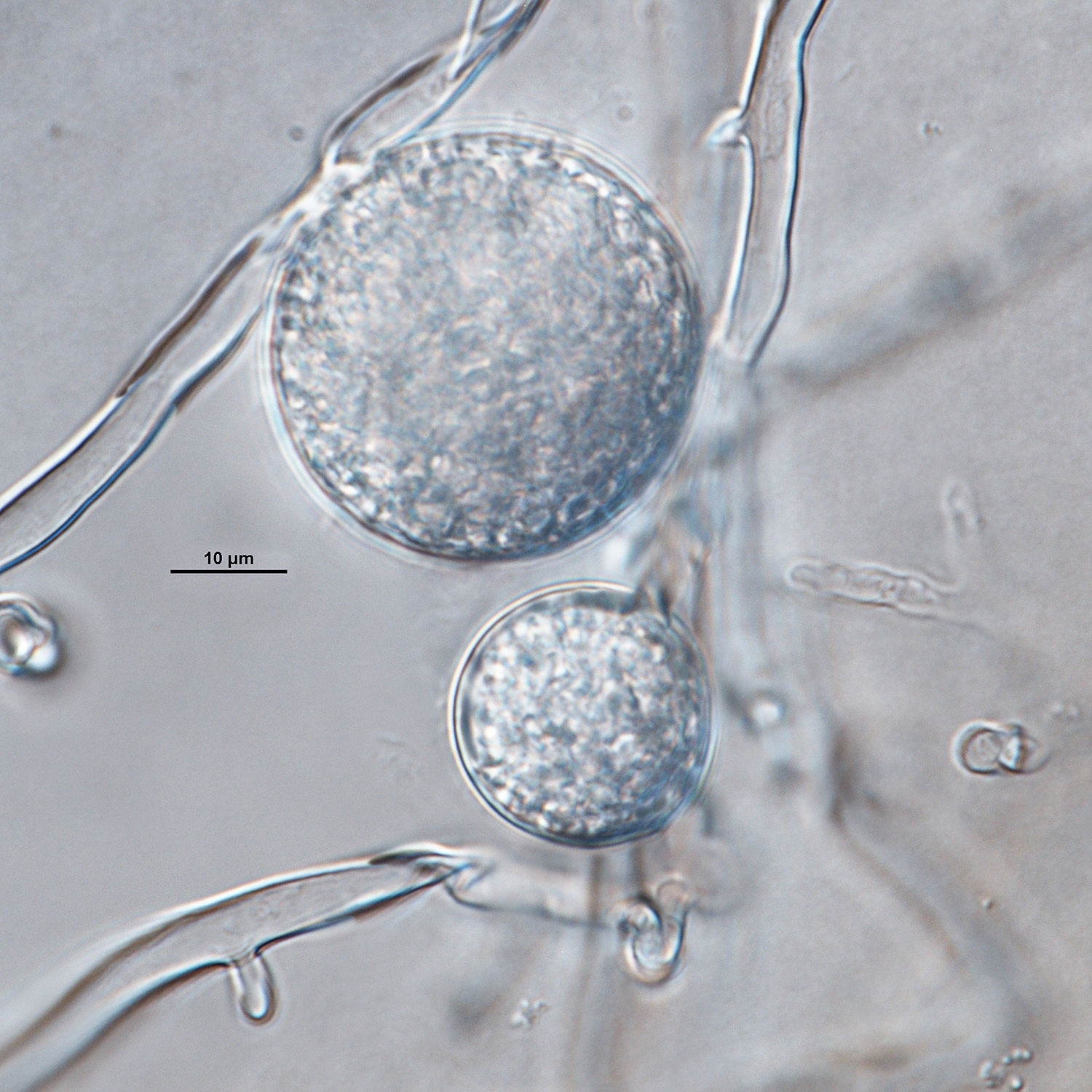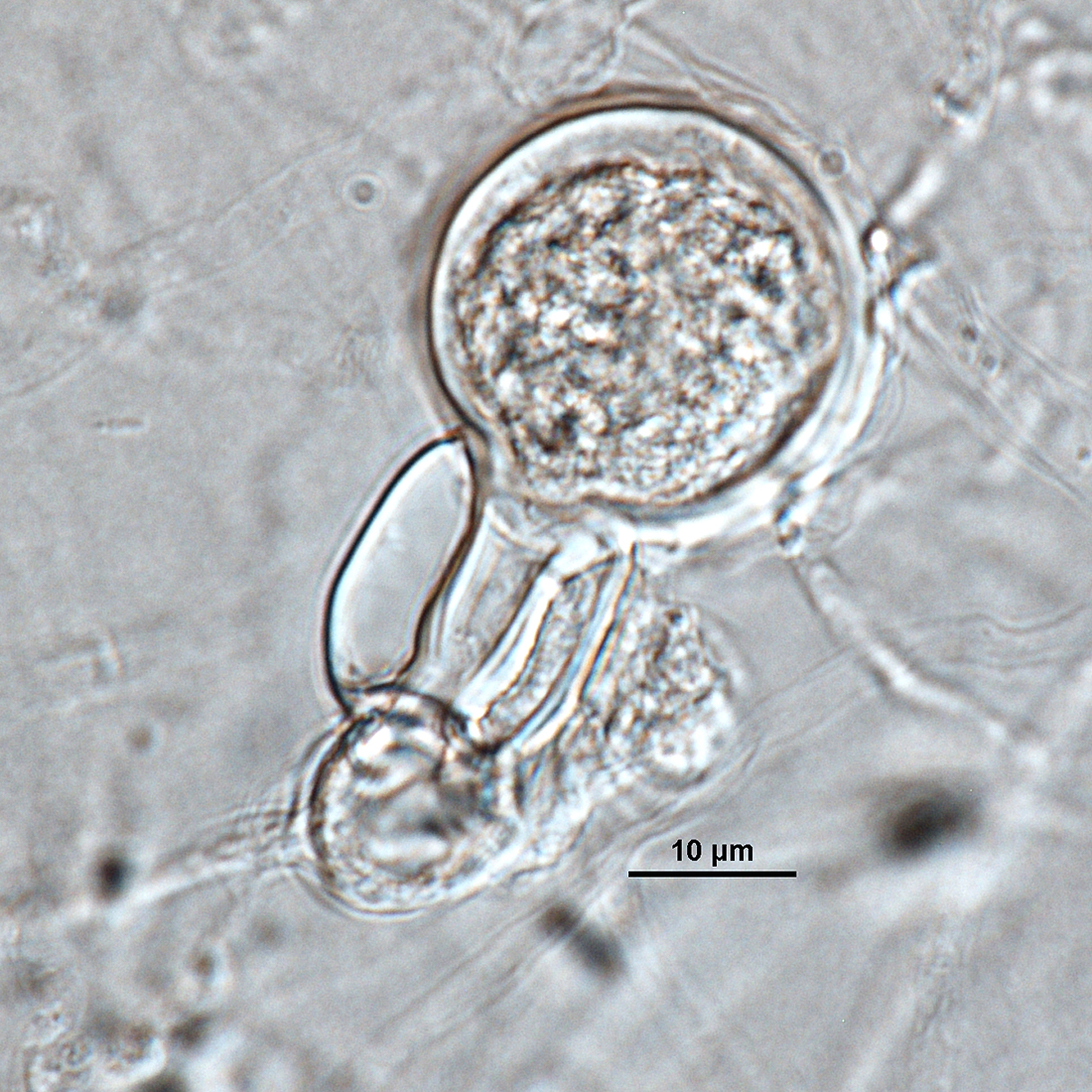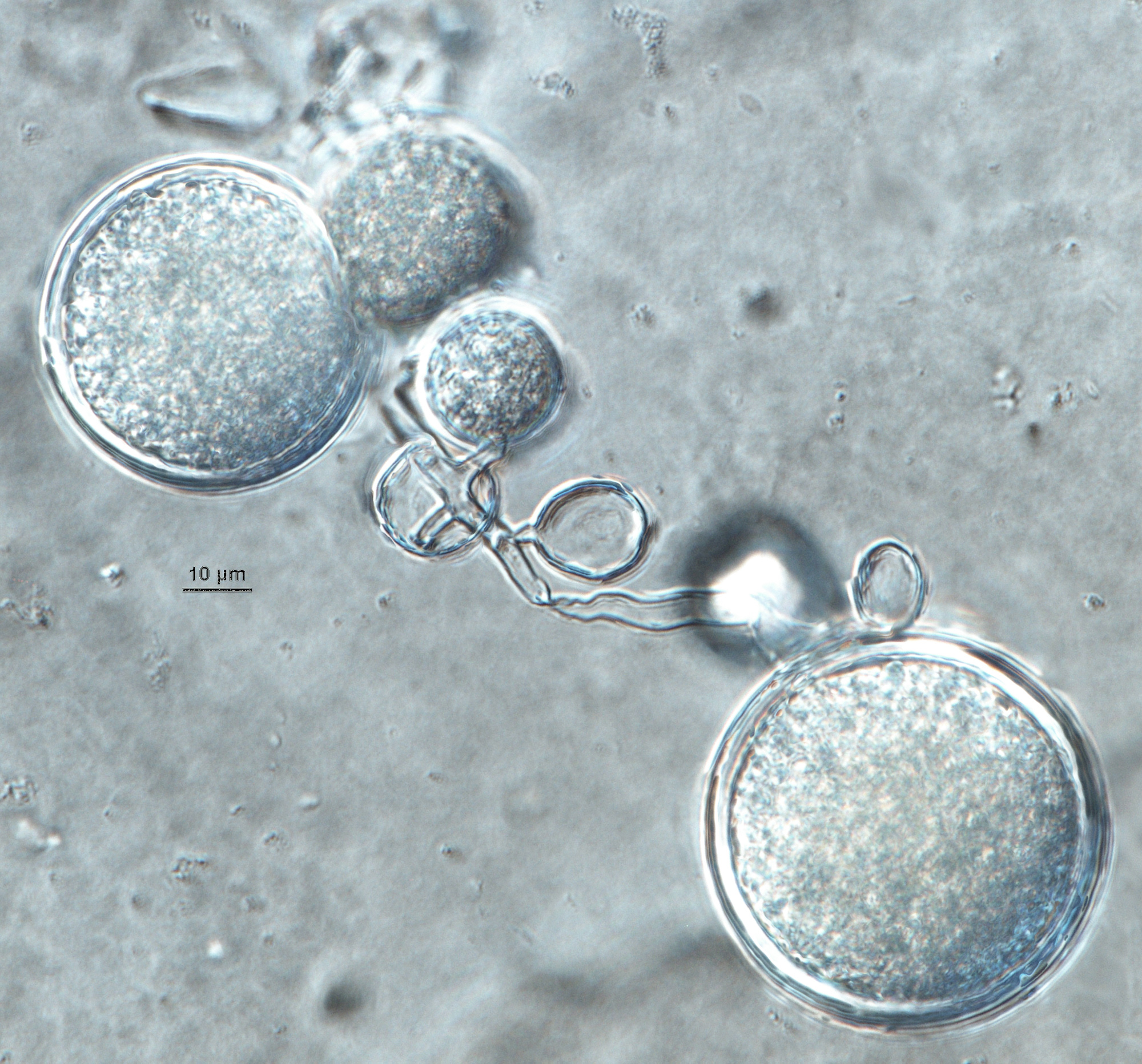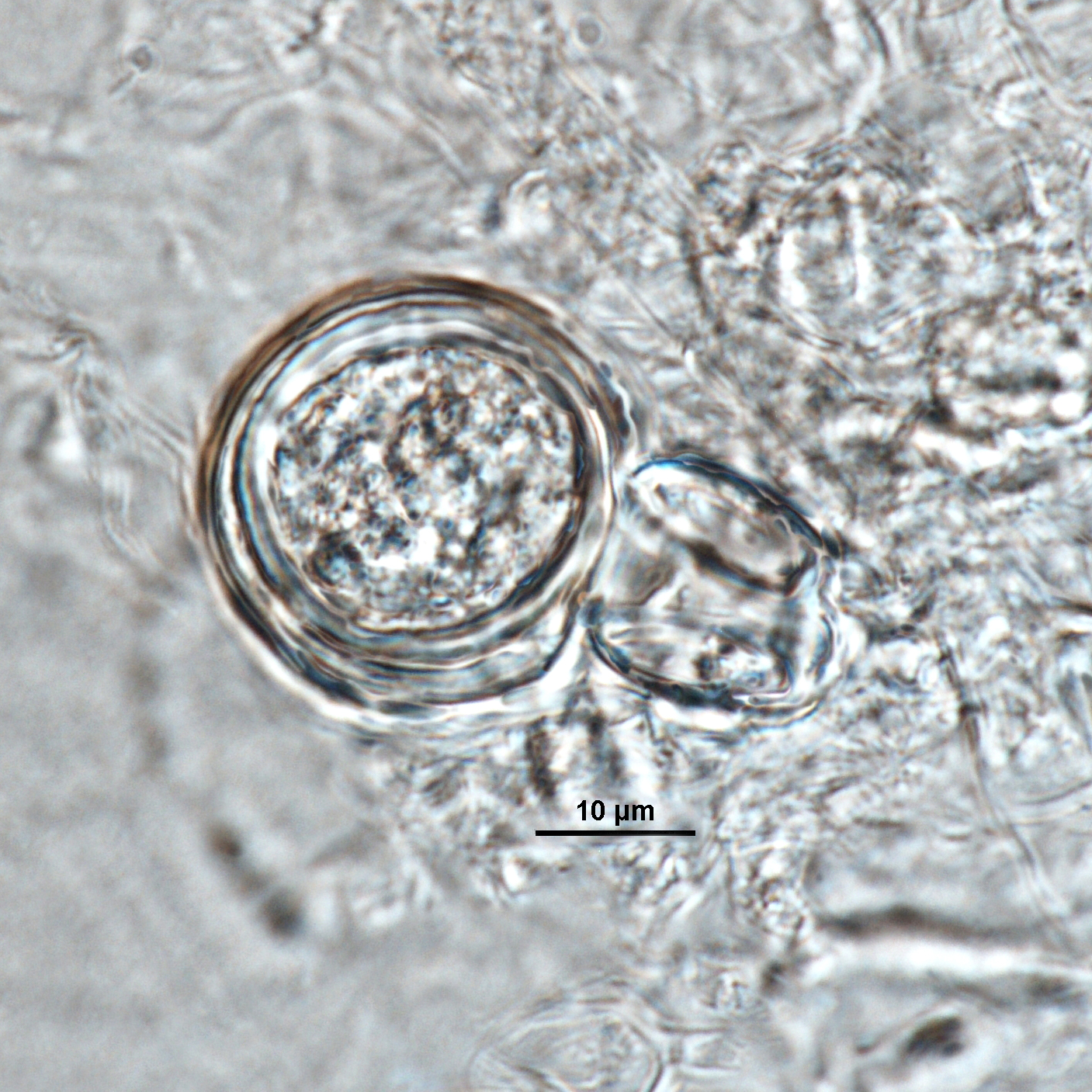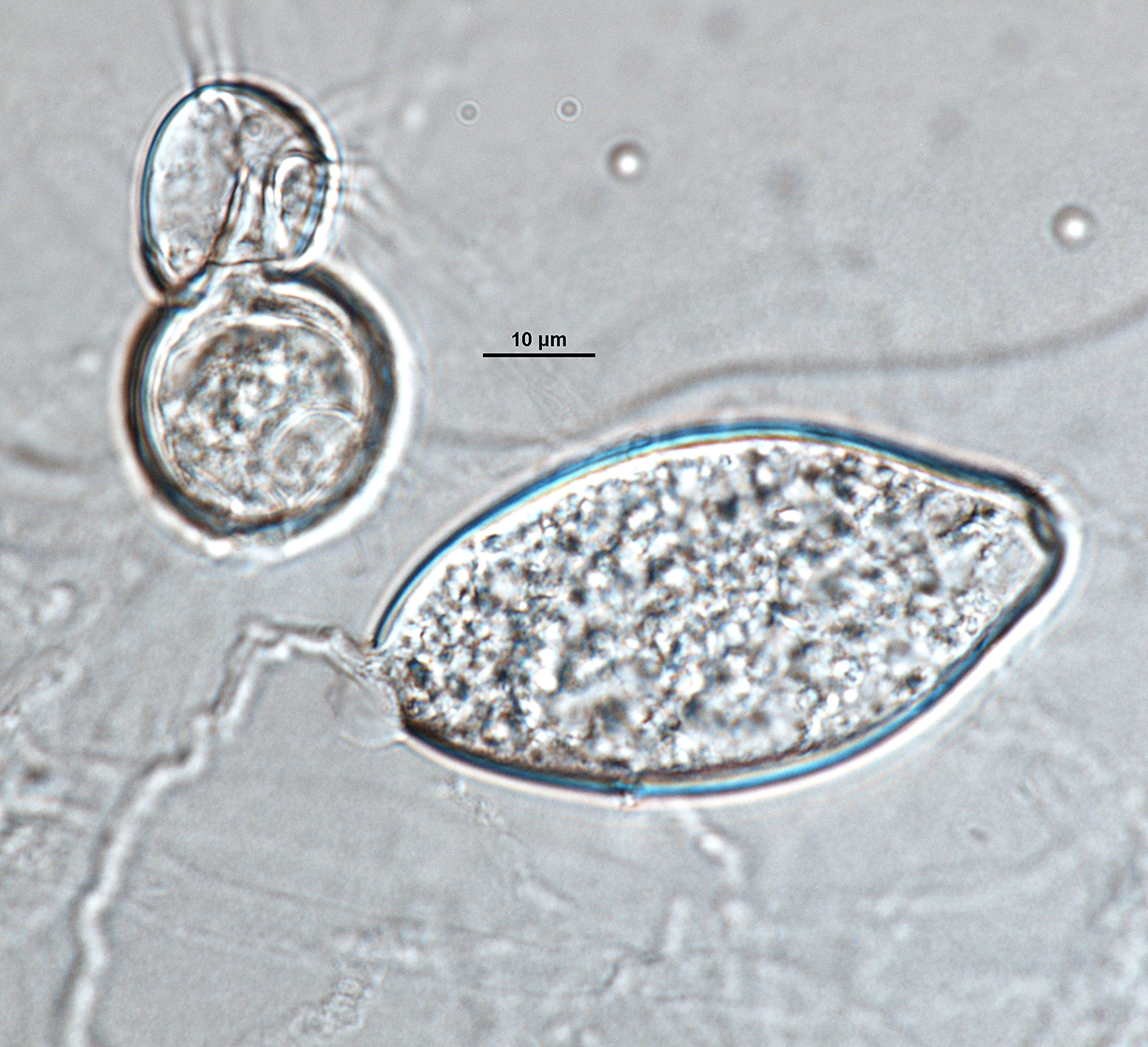Phytophthora ramorum
|
Phytophthora spp. in subclade 8c: portion of the seven-loci ML phylogeny featuring the type cultures of 212 described species (by T. Bourret). Notice the position of P. ramorum Ex-type CBS 101533 = S&T BL 55G. Gloria Abad, USDA S&T.
|
|
Phytophthora spp. in subclade 8c: Morphological Tabular key (PDF) and Tabular key legends (PDF) in IDphy2 KEY SECTION. Notice the data of P. ramorum Ex-type CBS 101533 = S&T BL 55G. Gloria Abad, USDA S&T.
|
|
Phytophthora ramorum (CPHST BL 55G) colonies of the ex-type grown for 7 days on (a) V8® Agar, (b) potato dextrose agar, and (c) malt extract agar; photo by Krysta Jennings and Leandra Knight, USDA-APHIS-PPQ |
|
Phytophthora ramorum (ex-type CPHST BL 55G) asexual phase (a–h): (a) sporangia in sporangiophores, (b–d) semipapillated sporangia with short pedicels; (e–h) chlamydospores, (f) terminal, (g, h) intercalary and lateral; photos by Gloria Abad, USDA-APHIS-PPQ. |
|
Phytophthora ramorum (ex-type CPHST BL 55G) sexual phase (a–e): (a) sporangium and sexual phase, (b–e) gametangia and plerotic oospores of ex-type (A1, EU1) produced with tester strain P. capsici (A2, ex-type CPHST BL 33); photos by Gloria Abad, USDA-APHIS-PPQ. |
|
Phytophthora ramorum mycelia and sporangiophore; photo by Gloria Abad, USDA-APHIS-PPQ |
|
Phytophthora ramorum (ex-type CPHST BL 55G) asexual phase: sporangia and sporangiophores; photo by Gloria Abad, USDA-APHIS-PPQ. |
|
Phytophthora ramorum (ex-type CPHST BL 55G) asexual phase: chlamydospores; photo by Gloria Abad, USDA-APHIS-PPQ. |
|
Phytophthora ramorum (ex-type CPHST BL 55G) asexual phase: semipapillated sporangium with short pedicel; photo by Gloria Abad, USDA-APHIS-PPQ. |
|
Phytophthora ramorum (ex-type CPHST BL 55G) asexual phase: semipapillated sporangium with short pedicel; photo by Gloria Abad, USDA-APHIS-PPQ. |
|
Phytophthora ramorum (ex-type CPHST BL 55G) sexual phase: plerotic oospore of ex-type (A1, EU1) produced with tester strain P. capsici (A2, ex-type CPHST BL 33); photo by Gloria Abad, USDA-APHIS-PPQ. |
|
Phytophthora ramorum (ex-type CPHST BL 55G) asexual phase: intercalary and lateral chlamydospores; photo by Gloria Abad, USDA-APHIS-PPQ. |
|
Phytophthora ramorum (ex-type CPHST BL 55G) sexual phase: plerotic oospore of ex-type (A1, EU1) produced with tester strain P. capsici (A2, ex-type CPHST BL 33); photo by Gloria Abad, USDA-APHIS-PPQ. |
|
Phytophthora ramorum (ex-type CPHST BL 55G) asexual phase: terminal chlamydospore; photo by Gloria Abad, USDA-APHIS-PPQ. |
|
Phytophthora ramorum (ex-type CPHST BL 55G) sexual phase: plerotic oospore of ex-type (A1, EU1) produced with tester strain P. capsici (A2, ex-type CPHST BL 33); photo by Gloria Abad, USDA-APHIS-PPQ. |
|
Phytophthora ramorum (ex-type CPHST BL 55G) asexual phase: intercalary and lateral chlamydospores; photo by Gloria Abad, USDA-APHIS-PPQ. |
|
Phytophthora ramorum (ex-type CPHST BL 55G) sexual phase: plerotic oospore of ex-type (A1, EU1) produced with tester strain P. capsici (A2, ex-type CPHST BL 33); photo by Gloria Abad, USDA-APHIS-PPQ. |
|
Phytophthora ramorum (ex-type CPHST BL 55G) asexual and sexual phases: sporangium and plerotic oospore of ex-type (A1, EU1) produced with tester strain P. capsici (A2, ex-type CPHST BL 33); photo by Gloria Abad, USDA-APHIS-PPQ. |
|
Phytophthora ramorum (ex-type CPHST BL 55G) asexual phase: semipapillated sporangium with short pedicel; photo by Gloria Abad, USDA-APHIS-PPQ. |
Name and publication
Phytophthora ramorum Werres, de Cock & Man in ’t Veld (2001)
Werres S, Marwitz R, Man in 't Veld WA, de Cock AWAM, Bonants PJM, de Weerdt M, Themann K, Ilieva E, and Baayen RP. 2001. Phytophthora ramorum sp. nov., a new pathogen on Rhododendron and Viburnum. Mycol. Res. 105: 1155–1165.
Corresponding author: s.werres@bba.de
Nomenclature
from Werres et al. (2001)
Mycobank
Etymology
"ramus", branch: referring to the pathogenicity to twigs and branches
Typification
Type: GERMANY, Niedersachsen, isolated from Rhododendron catawbiense ‘Grandiorum’ collected in a nursery by S. Werres during July 1995, BBA 9/95 (CBS 101553 - holotypus; BBA 9/95 - isotypus); herbarium number: CBS H-7707
Ex-type: CBS 101553 (mating type A1)
Sequences for ex-type in original manuscript: Although in the original manuscript of Werres et al. (2001), CBS 101553 is shown in figures 5a (ITS1) and 5b (ITS2) (pg 1163), no accession numbers are indicated for the species in the referred manuscript.
Ex-type in other collections
(ET) CBS 101553, WPC P10103, S&T BL 55G (Abad)
Molecular identification
Voucher sequences for barcoding genes (ITS rDNA and COI) of the ex-type (see Molecular protocols page)
Phytophthora ramorum isolate CPHST BL 55G (= P10103 WPC) = ITS rDNA MG865581, COI MH136973
Voucher sequences for Molecular Toolbox with seven genes (ITS, β-tub, COI, EF1α, HSP90, L10, and YPT1
(see Molecular protocols page) (In Progress)
Voucher sequences for Metabarcoding High-throughput Sequencing (HTS) Technologies [Molecular Operational Taxonomic Unit (MOTU)]
(see Molecular protocols page) (In Progress)
Sequences with multiple genes for ex-type in other sources
- NCBI: Phytophthora ramorum CPHST BL 55G
- NCBI: Phytophthora ramorum P10103
- NCBI: Phytophthora ramorum CBS 101553
- EPPO-Q-bank: Phytophthora ramorum CBS 101553
- BOLDSYSTEMS: Phytophthora ramorum (barcoding COI & ITS)
Position in multigenic phylogeny with 7 genes (ITS, β-tub, COI, EF1α, HSP90, L10, and YPT1)
Clade clade:
a taxonomic group of organisms classified together on the basis of homologous features traced to a common ancestor
8c
Genome sequence
Phytophthora ramorum strain ex-type CPHST BL 55G. Accession genome CPHST_55G Assem3, BioProject PRJNA510798, USDA-APHIS-PPQ-S&T (2019), Srivastava et al. 2020
Morphological identification
adapted from Werres et al. (2001)
Colonies and cardinal temperatures
Colony colony:
assemblage of hyphae which usually develops form a single source and grows in a coordinated way
morphology on PDA, V8, and MEA with non-distinct pattern. Minimum growth temperature 9°C, optimum 15–21°C, and maximum 27°C.
Conditions for growth and sporulation
Sporangia abundantly produced on agar as well as on plugs of culture media in soil extract. Sexual structures produced mostly in culture pairings with opposite types of other species (i.e. Phytophthora capsici, and Phytophthora cryptogea).
Asexual phase
SporangiaSporangia:
sac within which zoospores form, especially when water is cooled to about 10°C below ambient temperature; in solid substrates, sporangia usually germinate by germ tubes
semipapillatesemipapillate:
pertaining to the production of shallow having papilla that are not well developed, shallow and less nipple-like than fully papillate structures
; caducouscaducous:
pertaining to sporangia that become dislodged readily (i.e. deciduous) and separate from the sporangiophore (cf. persistent)
with short pedicels; ellipsoidellipsoid:
refers to a solid body that forms an ellipse in the longitudinal plane and a circle in cross section; many fungal spores are ellipsoidal or elliptic
, ovoidovoid:
egg-shaped, with the widest part at the base of the sporangium and the narrow part at the apex
(22–71 L x 15–40 W µm) sometimes with tapered bases and with conspicuous basal plugs; originated in unbranched or in simple sympodial sporangiophores. Hyphal swellings absent. Irregular coralloid myceliamycelia:
mass of hyphae constituting the body, or thallus, of fungi and oomycetes; in <em>Phytophthora</em> species, mycelia is coenocytic
are observed. ChlamydosporesChlamydospores:
an asexual spore with a thickened inner wall that is delimited from the mycelium by a septum; may be terminal or intercalary, and survives for long periods in soil
globose, subglobose (24–58 µm diam), produced commonly terminal or intercalaryintercalary:
positioned within a hypha (cf. terminal)
and occasionally lateral.
Sexual phase
Heterothallicheterothallic:
pertaining to sexual reproduction in which conjugation is possible only through interaction of different thalli (i.e. different mating types) (cf. homothallic)
. OogoniaOogonia:
the female gametangium in which the oospore forms after fertilization by the antheridium
smooth-walled, globoseglobose:
having a rounded form resembling that of a sphere
(23–38 µm diam) some with tapered bases; antheridiaantheridia:
the male gametangium; a multinucleate, swollen hyphal tip affixed firmly to the wall of the female gametangium (the oogonium)
amphigynousamphigynous:
pertaining to the sexual stage in which the antheridium completely surrounds the stalk of the oogonium (cf. paragynous)
, spherical, ovoidovoid:
egg-shaped, with the widest part at the base of the sporangium and the narrow part at the apex
, club-shaped, sometimes with digitate projections; oosporesoospores:
zygote or thick-walled spore that forms within the oogonium after fertilization by the antheridium; may be long-lived
plerotic to slightly apleroticaplerotic:
pertaining to a mature oospore that does not fill the oogonium; i.e. there is room left between the oospore wall and oogonium wall (cf. plerotic)
(20–33 µm diam).
Most typical characters
Phytophthora ramorum is characterized by the ellipsoidellipsoid:
refers to a solid body that forms an ellipse in the longitudinal plane and a circle in cross section; many fungal spores are ellipsoidal or elliptic
to elongate sporangiasporangia:
sac within which zoospores form, especially when water is cooled to about 10°C below ambient temperature; in solid substrates, sporangia usually germinate by germ tubes
with short pedicels and the large chlamydosporeschlamydospores:
an asexual spore with a thickened inner wall that is delimited from the mycelium by a septum; may be terminal or intercalary, and survives for long periods in soil
(>30 µm diam).
Additional specimen(s) evaluated
Phytophthora ramorum ex-type CPHST BL 55G, duplicate of P10103 (World Phytophthora Collection)
Hosts and distribution
Distribution: Europe, North America (Canada, USA: WA, OR, CA). It was recently introduced via nursery shipments from western states to many other states in the USA; strict quarantine restrictions have been implemented to combat its spread.
Substrate: twigs, branches
Disease note: an aggressive forest pathogen, cause of sudden oak death; originally described as a twig and branch blight of Rhododendron
Host: at least 26 genera in 17 families, including Rhododendron spp. (Ericaceae) and Quercus spp. (Fagaceae)
Retrieved February 01, 2018 from U.S. National Fungus Collections Nomenclature Database.
Additional info
Substrate: trunk/foliage
Quarantine status
USDA/APHIS: Phytophthora ramorum regulations
Phytophthora ramorum is also listed in the U.S. Regulated Plant Pest Table (last modified Nov. 15, 2017).
EPPO: Phytophthora ramorum was previously listed on the EPPO alert list (at the bottom of this page).
Additional references and links
- SMML USDA-ARS: Phytophthora ramorum
- EPPO Global Database: Phytophthora ramorum
- Forest Phytophthoras of the world: Phytophthora ramorum
- CABI Digital Library: Phytophthora ramorum
- Forestry Commision UK: Phytophthora ramorum
- Encyclopedia of Life (EOL): Phytophthora ramorum
- Index Fungorum (IF): Phytophthora ramorum
- Google All Phytophthora ramorum
- Google Images Phytophthora ramorum
- Google Scholar Phytophthora ramorum
- Forestry Commision Scotland Phytophthora ramorum
- Forestry Commission Great Britain Phytophthora ramorum
- California Oak Mortality Task Force
- Phytophthora ramorum in OSU Phytophthora Online course: Training for Nursery Growers, Oregon State University
- APS: Sudden oak death and ramorum blight
Fact sheet author
Z. Gloria Abad, Ph.D., USDA-APHIS-PPQ-S&T Plant Pathogen Confirmatory Diagnostics Laboratory (PPCDL), United States of America.


